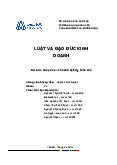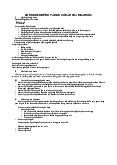













Preview text:
I. INTRODUCTION E-LEARNING WHAT IS E-LEARNING?
E-learning (Electronic Learning)-an online learning method through the Internet to meet
learning, refer to related documents, interact and exchange between students and lectures without
having to meet face-to-face. E-learning is a form of distance learning and training based on
modern technological devices and Internet connection. In addition, there are a few other tools for E-learning such as:
_ Computer Based Learning (CBL) _ Web-Based Learning (WBL)
_ Multimedia-Based Learning (MBL) WHY WE CHOOSE IT?
Online learning, often known as E_learning, was created to meet the need for education and
training, following the trend of integration in Vietnamese education and training.
E-learning is an advanced educational method that links students and lectures using
current information technology. Teachers can create their own textbooks using e-learning in a
variety of formats, including video lectures, illustrations, gamification, etc. Use the Internet or
Broadband transmission to communicate them to students and engage in conversation.
The international economy is transitioning to a knowledge-based economy, and each
nation’s existence and future development depend critically on how well education and training standards are improved.
The current software development, which takes advantage of the internet environment,
creates highly shareable programs that function on any operating system and regardless of
location, generating beneficial conditions for everyone to easily and conveniently
communicate information, search for information, and learn. Learning is something that
everyone, regardless of age or living situation, can do, not just children and students in schools.
E-learning has gone through comprehensive testing and is being utilized widely throughout the world, including Vietnam.
II. DESCRIBE WHY DEVELOPING A DIGITAL BUSINESS PLAN IN THE
EDUCATIONAL TECHNOLOGY IS ESSENTIAL
Developing a digital business plan in educational technology is essential for several reasons
Firstly, the use of technology in education is becoming increasingly important as it has the
potential to transform the way we teach and learn. Technology can offer new and innovative
ways to deliver content, engage students, and provide feedback, among other things. A digital
business plan can help educational technology companies to identify the needs of the education
sector and develop solutions that meet those needs.
Secondly, the education technology industry is growing rapidly, and there is a lot of competition
in the market. A digital business plan can help companies to differentiate themselves from their
competitors and create a unique value proposition that appeals to their target audience
Thirdly, a digital business plan can help educational technology companies to identify their target
market and develop a marketing strategy that effectively reaches that market. This is important
because the education sector is diverse and includes a range of stakeholders, including teachers,
students, parents, and administrators
Fourthly, a digital business plan can help educational technology companies to set clear goals
and objectives and develop a plan for achieving those goals. This can include developing
a product roadmap, identifying key partners and collaborators, and establishing metrics for measuring success.
Finally, a digital business plan can help educational technology companies to secure funding and
investment. Investors want to see a clear plan for how a company will achieve its goals and
generate revenue, and a well-developed digital business plan can provide this.
IS THERE AN OPPORTUNITY FOR THE BUSINESS MODEL TO GROW?
( NGUYÊN CÂU NÀY RIÊNG RA 1 SLIDE ĐỂ TUI TỰ NÓI NHEN ) 2.1 STRATEGY ANALYSIS
The external environment -
The external environment for educational technology includes various factors such as
government regulations, technological advancements, economic conditions, social and
cultural factors, demographics, competitive landscape, and global trends that can impact
the growth and development of the industry. Educational technology companies must be
aware of these external factors and adapt to changes in the environment to remain
competitive and meet the evolving needs of their customers. The internal resourses -
Internal resources such as human, financial, technological, intellectual property, and
partnerships are essential for the development and implementation of a digital business
plan in educational technology. Educational technology companies need to leverage these
resources effectively to develop innovative digital solutions, differentiate themselves
from competitors, and meet the evolving needs of their customers. Strategic objective Vision -
The vision of educational technology is to use technology to transform the teaching and
learning experience, making it more personalized, accessible, collaborative, innovative,
and supportive of lifelong learning. This vision is built on the belief that technology can
play a critical role in improving education and addressing the challenges faced by
education systems around the world. Mission -
The mission of educational technology is to enable and enhance teaching and learning
through the effective use of technology. This mission is focused on enhancing learning
experiences, improving teaching effectiveness, increasing access to education, promoting
collaboration, and facilitating lifelong learning. By achieving these objectives,
educational technology can help to create a more engaging, effective, and inclusive
learning environment that meets the diverse needs of learners. Objective -
The objectives of educational technology are focused on enhancing the teaching and
learning experience, improving learning outcomes, increasing access to education,
supporting the development of 21st-century skills, and fostering lifelong learning. By
achieving these objectives, educational technology can help to create a more engaging,
effective, and inclusive learning environment that meets the diverse needs of learners. Strategic Definition Option generation -
Companies can consider options such as developing a learning management system,
creating digital content, leveraging gamification, adopting emerging technologies,
partnering with educational institutions, and adopting a freemium model. By evaluating
and selecting appropriate options, they can create innovative solutions that enhance the
teaching and learning experience, improve learning outcomes, increase access to
education, and foster lifelong learning. Option evaluation -
Option evaluation is essential to ensure that educational technology companies select the
most appropriate options for achieving their objectives and create effective and
innovative solutions that enhance the teaching and learning experience, improve learning
outcomes, increase access to education, and foster lifelong learning. Option Sellection
1. Review and refine options: Educational technology companies need to review and
refine the options identified during the option generation and evaluation phases to ensure
that they are aligned with their objectives and meet the needs of learners and educators.
2. Prioritize options: Companies need to prioritize the most suitable options based on
factors such as feasibility, sustainability, impact on learners and educators, cost-
effectiveness, and scalability.
3. Consider trade-offs: Companies may need to consider trade-offs between different
options, such as cost versus impact or short-term versus long-term benefits.
4. Develop implementation plans: Once the options are selected, companies need to
develop detailed implementation plans that outline the steps required to implement the
chosen options. This includes identifying resources, timelines, milestones, and performance indicators.
5. Monitor and adjust: Finally, companies need to monitor the implementation of the
chosen options and adjust them as needed based on feedback, performance data, and
changing needs and circumstances.
Strategic implementation Planning
1. Identify objectives: The first step in planning for educational technology is to identify
clear and specific objectives that align with the needs of learners and educators. These
objectives should be measurable and achievable.
2. Conduct research: Educational technology companies need to conduct extensive
research to identify the latest trends, emerging technologies, and best practices in
education and technology. This research will help companies to identify potential options
for achieving their objectives.
3. Generate options: Based on the research, educational technology companies need to
generate multiple options for achieving their objectives. These options may include
developing a learning management system, creating digital content, leveraging
gamification, adopting emerging technologies, partnering with educational institutions, and adopting a freemium model.
4. Evaluate options: Educational technology companies need to evaluate the potential
options based on factors such as alignment with objectives, feasibility, sustainability,
impact on learners and educators, cost-effectiveness, and scalability.
5. Select options: Based on the evaluation results, educational technology companies need
to select the most appropriate options and develop detailed implementation plans for each option.
6. Implement plans: Educational technology companies need to implement the selected
options according to the detailed implementation plans. This includes allocating
resources, establishing timelines, and monitoring progress.
7. Evaluate and adjust: Finally, educational technology companies need to evaluate the
effectiveness of their solutions and adjust them as needed based on feedback,
performance data, and changing needs and circumstances Execution -
Execution of educational technology requires a commitment to providing the necessary
resources, establishing clear timelines and milestones, training educators and learners,
testing and iterating, monitoring and evaluating, and continuously improving. Control
Control of educational technology requires a commitment to establishing governance structures,
monitoring usage, managing risks, measuring performance, and evaluating and adjusting digital
solutions to ensure that they are being used in a responsible and effective manner. 2.2 2.3 2.4 What is IS?
IS (stands for Information System) is a combination of people, processes, data, and
technology that work together to collect, process, store, and disseminate information in an organization
Why does an E–Learning DB need IS? (Roles of IS in an E-Learning DB) -
Not only does an E-Learning DB need IS to implement its system fluently but every
business needs it. How IS supports the DB? -
First: learning management: IS will help businesses in managing courses. It will build
features such as student registration, content management, assignment creation, ... -
Second: Interaction and Communication: IS provides online communication tools
such as discussion forums, messaging systems, online meeting software, ... -
Third: Assessment and monitoring: IS will help in monitoring students' academic
progress so that they can evaluate students' academic performance and leave feedback
Next, we will look at how IS helps to manage the DB strategies outlined above
How has IS helped businesses manage buy-side and sell-side? -
SRM: stands for Supplier Relationship Management
Buy-side: SRM will assist businesses in managing factors on the buy-side (courses, teachers,).
SRM functions provided to businesses such as: -
Learning Content Management: SRM helps manage and optimize relationships with
learning content providers in E-learning Digital Business. It includes the evaluation,
selection, and monitoring of the provider to ensure the quality and reliability of the content provided -
Contract negotiation: SRM assists in negotiating contracts with partners and suppliers in
the field of E-learning (course providers, teachers, equipment suppliers,). It ensures that
contract terms and conditions are properly agreed upon and protects the interests of E- learning Digital Business -
Supplier Performance Evaluation: SRM allows evaluating supplier performance in the
E-learning Digital Business (performance of instructors, quality of courses, equipment,..).
This helps ensure that the supplier meets deadlines, delivers quality, and adheres to the commitments that have been set -
Procurement Process Optimization: SRM can help optimize procurement processes
involving suppliers and partners in E-learning Digital Business. (e.g., there must always
be a backup instructor to replace incidents that occur when the lead teacher fails to attend class,...) SRM PROCESS
Identify needs: what to source for (courses, technological equipment, customer service,...)
Search and selection of suppliers: Conduct a search and selection of suppliers in
accordance with predefined requirements and standards. Evaluate potential providers based on
their ability to provide an e-learning platform, digitalization of content, training skills, technical support, and other factors.
Contract negotiation: Negotiate contract terms and conditions with the selected supplier.
Important factors can include content ownership, quality commitment, data security, technical
support, pricing, and delivery times.
Supplier Performance Management: Monitor and evaluate supplier performance based
on predefined criteria. This includes tracking content quality, platform reliability, technical
support time, and customer satisfaction.
Continuous improvement: Conduct continuous evaluation and improvement of the
supplier relationship management process. Look for opportunities to optimize processes,
improve service quality, and meet new requirements in the field of e-learning digital business.
ISCM: stands for internal supply management system, it can help businesses with functions such as: -
Track Sourcing Management: ISCM helps track and manage the sourcing of online
learning content, teaching materials, learning tools, and equipment -
Warehouse management: ISCM assists in warehouse management, helping to track the
quantity and location of materials, learning content, and equipment. This helps businesses
maintain readiness and efficiency in providing to customers. -
Optimizing supply chain operations: ISCM helps optimize supply chain operations,
from managing faculty and staff, managing instructional scheduling and technical
support, to ensuring regulatory compliance and quality in the delivery of learning services. -
Performance analysis and evaluation: ISCM provides tools to analyze and evaluate
supply chain performance, from measuring transit time, and warehouse performance, to
evaluating service quality and customer satisfaction. ISCM PROCESS
Identify needs: First, identify the needs of customers and e-learning businesses,
including learning needs, content, technology, and support services.
Planning: Establish an ISCM plan based on factors such as the number of trainees,
quantitative content, supplies, and delivery times.
Search and select supplies: Search and evaluate sources of content, technology,
equipment, and related services. Evaluate the quality, supply ability, and price to choose the right partner.
Management and control: Establish process management systems and control the
delivery of content, technology, and services. Ensure compliance and quality according to set standards.
Monitoring and evaluation: ISCM process monitoring, and evaluating the efficiency
and performance of supplies and processes. Make improvements and adjustments as needed
Engage with customers: Build good relationships with customers, listen to their
feedback and requests, and provide support and advice related to the ISCM process and specific requirements.
Optimization and development: Continuously optimize ISCM processes, seek ways to
improve performance and quality, and develop ISCM systems according to the development of e-
learning business and customer needs.
CRM: CUSTOMER RELATIONSHIP MANAGEMENT
Customer (student) information management: CRM helps collect and manage
information about students in E-learning Digital Business, including names, addresses, contact
information, course attendance history, access behavior, and student learning progress. This helps
build detailed student profiles and enhances better understanding and customer service.
Customer interaction and care: CRM provides tools to interact with customers in E-
learning Digital Business (e.g. chatbox, teacher contact,...). It helps record information about
calls, emails, messages and other interactions with customers. Thereby, CRM helps build a better
relationship with customers, providing personalized customer support and care.
Marketing campaign management: CRM assists in managing and tracking marketing
and advertising campaigns in E-learning Digital Business. It allows tracking campaign
performance, analyzing data, and generating reports to measure the effectiveness of marketing
activities and capture customer needs.
Learning Interaction Management: CRM can assist in managing student learning
interactions in E-learning Digital Business. It helps to record each student's learning progress,
progress, and achievements, thereby creating personalized learning suggestions and providing
the right support to each client.
Analytics and reporting: CRM provides tools to analyze data and create reports in E-
learning Digital Business. It helps evaluate business performance, measure customer
engagement, shape business strategy, and improve workflow. CRM PROCESS
Collect customer information: CRM systems will help collect and store detailed
information about customers, including names, contact information, purchase history,
preferences, and customer behavior.
Customer classification: Based on the information collected, the CRM system will help
categorize customers according to criteria such as interest, engagement, or purchase potential.
This helps businesses better understand each customer group and create appropriate strategies.
Building customer relationships: The CRM system process supports digital e-learning
businesses in building and maintaining relationships with customers. The system allows sending
messages, providing educational content, and creating interactive activities such as surveys, comments, and reviews.
Optimize sales process: CRM systems help manage the sales process from creating
quotes, managing contracts, tracking deal progress, and booking appointments. This process
enhances sales performance and ensures effective interaction with customers.
Data analysis and reporting: CRM systems provide tools to analyze data and generate
reports on business activities. This helps digital e-learning businesses evaluate the effectiveness
of marketing campaigns, measure customer interaction, and find new business development opportunities.
HOW CAN BUSINESSES MANAGE THE ABOVE INDEPENDENT SYSTEMS?
ERP: ENTERPRISE RESOURCE PLANNING ERP is the solution
Process and data integration: ERP enables the integration of processes and data
throughout the e-learning system. This increases consistency and the ability to track information
from different aspects of the business, including course management, learning materials, student
information, billing, and faculty management.
Business Process Optimization: ERP provides tools to optimize business processes in e-
learning digital business. This includes the enrollment process, classroom management,
document management, student management, instructor management, billing, and customer
support. Process optimization enhances efficiency and reduces processing time.
Enhanced financial management: ERP provides powerful financial management tools
for e-learning digital business. This includes budget management, payment management, invoice
management, revenue and expenditure management, and financial reporting. From there,
businesses can monitor and control the financial situation effectively.
Human resource management: ERP supports human resource management in e-
learning digital business. This includes employee information management, work schedule
management, payroll management, and skills and training management. Effective human
resource management helps ensure employee development and satisfaction
Enhanced analytics and reporting capabilities: ERP provides the ability to analyze
data and generate reports for e-learning digital businesses. This gives you a holistic view of your
business and supports strategic decisions.
3. ASSESS THE FEASIBILITY OF THE DIGITAL BUSINESS STRATEGY
PROPOSED. WHAT CHALLENGES/DIFFICULTIES MIGHT ARISE IF THE
STRATEGY IS PUT INTO ACTION? For sell-side:
Lack of input data: CRM needs complete and accurate customer data to work
effectively. However, the sell side usually doesn't have much information about the customer.
Difficulty in collecting data: Sell-side must rely on marketing channels to collect
customer information such as websites, and email. This is not easy.
Lack of resources: The application of CRM often requires large resources in
terms of staff, funds, and time from the sell side. They can have a hard time balancing
this resource need with their day-to-day sales operations.
Cultural and operational change: CRM brought about major changes in the
culture and operations of the sell side, requiring them to monitor and manage customer
data more closely. This can be difficult at first.
Integrating existing systems: The CRM system needs to connect and integrate
with existing software and systems such as ERP, website, etc. This can be a challenge for the sell side. For buy-side:
Vendor cooperation: Many suppliers may not be interested in adopting SRM and
improving partnerships. They may not cooperate fully.
Difficulty in sharing information: Many suppliers are afraid to share detailed
information about products, services, production processes, etc. with the buy side. They
are concerned about security and competition.
Lack of experience and expertise: The Buy-side may lack experts with
experience in implementing and operating SRM effectively. They must train staff during the application process.
Too many suppliers: The buy side often has to manage relationships with many
different suppliers. This increases the difficulty of applying SRM.
High initial investment costs: The cost of software, infrastructure, and staff
training can be huge for the buy side. They need to think carefully before investing. For businesses:
High initial cost: The construction and application of the ISCM system require a
large investment in technology, infrastructure, and human resources. Enterprises must pay
for software, equipment, consulting services, and training.
Difficulty integrating information and systems: Existing business, accounting,
and operations management systems are often not fully compatible with each other.
Integrating them to serve ISCM is a big challenge.
Difficulty in convincing supply chain partners to participate: Many supply
chain partners are afraid to share information and data with each other. Businesses need a
lot of effort to convince them to join.
Lack of experienced human resources: The effective application of ISCM
requires the support of experienced experts and managers. However, this manpower is scarce and expensive. IV. CONCLUSION
E-Learning: Strategies for Delivering Knowledge in the Digital Age, is an excellent
resource for any organization investigating the need to implement e-learning and for those
organizations with established e-learning programs. The strategies and tools presented offer
practical, sound business methodologies to accomplish broad integration of e-learning into the
learning organization, in addition to identifying areas where it may not be practical or effective.
Two important concepts are presented in this book and are worthwhile to reiterate. The
discussion on the justification and measurement model for e-learning using well-established
business metrics of cost, quality, service, and speed are important metrics. Critical success
factors for implementing an e-learning strategy including culture, champions, communication,
and change are most important for any new enterprise-wide initiative.




